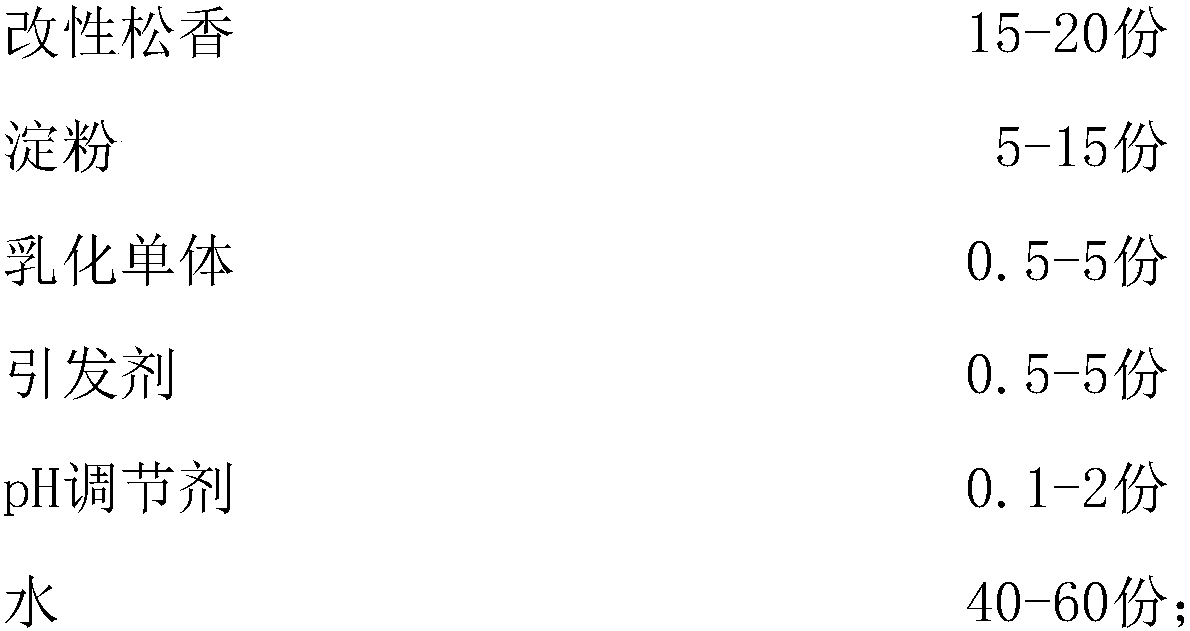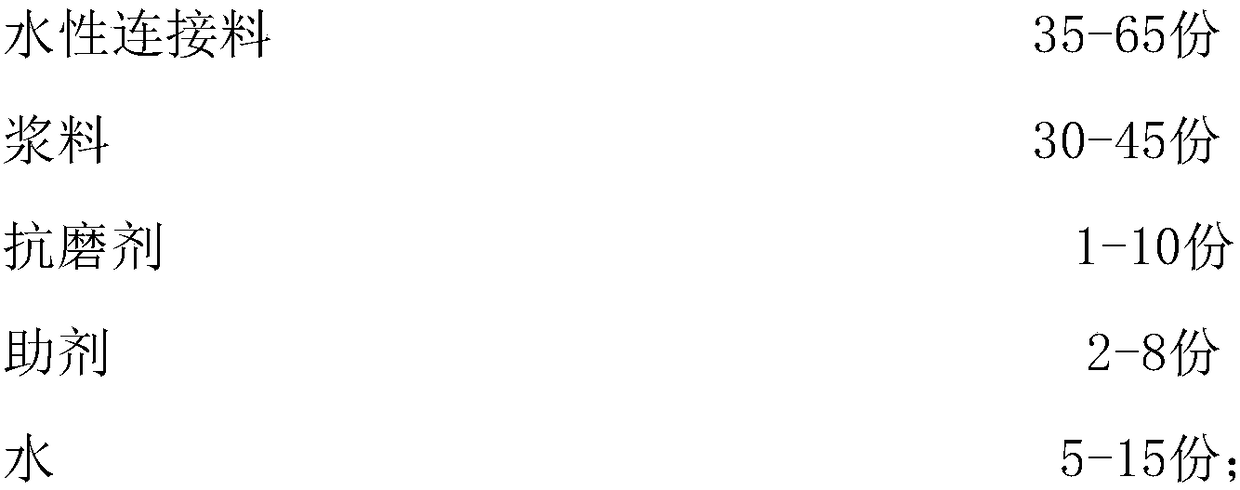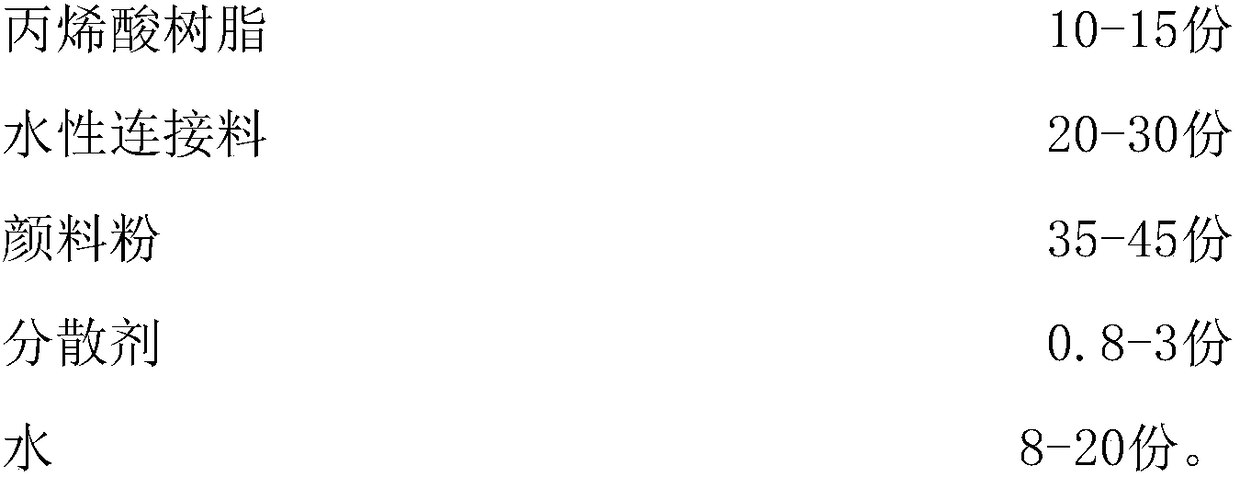Waterborne binder and food-contact waterborne printing ink prepared by using waterborne binder
A technology of water-based ink and binder, which is applied in the ink field to achieve the effects of increasing the polymerization reaction rate, increasing the initiation efficiency, and increasing the contact area
- Summary
- Abstract
- Description
- Claims
- Application Information
AI Technical Summary
Problems solved by technology
Method used
Image
Examples
Embodiment 1
[0048] A water-based binder, comprising the following raw materials in parts by weight:
[0049]
[0050] Each part of the emulsifying monomer is prepared by the following method: stirring 20 parts of acrylic monomer, 50 parts of styrene monomer, 0.5 part of emulsifier, and 20 parts of water at a temperature of 30°C to obtain the emulsifying monomer.
[0051] Each part of the modified rosin is prepared from the following steps:
[0052] (1) Heat 50 parts of rosin to 180°C, then add 15 parts of maleic anhydride, and react at 180°C for 2 hours to obtain System A;
[0053] (2) Raise the temperature of System A to 200°C, then dropwise add 20 parts of monomers containing double bonds and hydroxyl groups, 20 parts of monomers containing double bonds and amino groups, 0.5 parts of polymerization inhibitor and 0.5 parts of zinc oxide, and then raise the temperature to 220°C Insulate for 1 hour to obtain system B;
[0054] (3) Raise the temperature of system B to 270° C., add 10 p...
Embodiment 2
[0072] A water-based binder, comprising the following raw materials in parts by weight:
[0073]
[0074] Each part of the emulsifying monomer was prepared by the following method: stirring 70 parts of styrene monomer, 5 parts of emulsifier, and 30 parts of water at 45° C. to obtain the emulsifying monomer.
[0075] Each part of the modified rosin is prepared from the following steps:
[0076] (1) Heat 60 parts of rosin to 190°C, then add 20 parts of maleic anhydride, and react at 190°C for 3 hours to obtain System A;
[0077] (2) Raise the temperature of system A to 210°C, then dropwise add 25 parts of monomers containing double bonds and hydroxyl groups, 5 parts of polymerization inhibitors and 5 parts of zinc oxide, and then raise the temperature to 240°C for 2 hours to obtain system B;
[0078] (3) Raise the temperature of system B to 285°C, add 15 parts of polyols, then cool down to 180°C and discharge to obtain the modified rosin.
[0079] The monomer containing dou...
Embodiment 3
[0097] A water-based binder, comprising the following raw materials in parts by weight:
[0098]
[0099] Each part of the emulsifying monomer is prepared by the following method: 20 parts of acrylic monomer, 70 parts of styrene monomer, 4 parts of emulsifier, and 25 parts of water are stirred at a temperature of 40° C. to obtain the emulsifying monomer.
[0100] Each part of the modified rosin is prepared from the following steps:
[0101] (1) Heat 55 parts of rosin to 185°C, then add 18 parts of maleic anhydride, and react at 185°C for 2.5 hours to obtain System A;
[0102] (2) Raise the temperature of system A to 210°C, then dropwise add 23 parts of monomers containing double bonds and amino groups, 4 parts of polymerization inhibitors, and 4 parts of zinc oxide, and then raise the temperature to 230°C for 1.5 hours to obtain system B;
[0103] (3) Raise the temperature of system B to 275°C, add 12 parts of polyol, then cool down to 175°C and discharge to obtain the mod...
PUM
 Login to View More
Login to View More Abstract
Description
Claims
Application Information
 Login to View More
Login to View More - R&D
- Intellectual Property
- Life Sciences
- Materials
- Tech Scout
- Unparalleled Data Quality
- Higher Quality Content
- 60% Fewer Hallucinations
Browse by: Latest US Patents, China's latest patents, Technical Efficacy Thesaurus, Application Domain, Technology Topic, Popular Technical Reports.
© 2025 PatSnap. All rights reserved.Legal|Privacy policy|Modern Slavery Act Transparency Statement|Sitemap|About US| Contact US: help@patsnap.com



